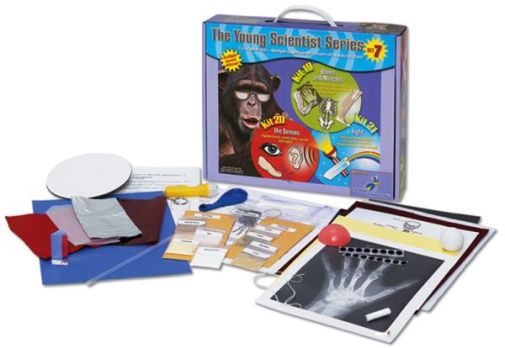We use cookies to make your experience better. To comply with the new e-Privacy directive, we need to ask for your consent to set the cookies. Learn more.
Young Scientists Set 7 - Kits 19-21
- Small parts. Not for children under 3 years.
- Children under 8 years can choke or suffocate on uninflated or broken balloons. Adult supervision required. Keep uninflated balloons away from children. Discard broken balloons at once.
- Toy contains a small ball. Not for children under 3 years.
Bones and Muscles; The Senses; Light
In a market saturated with both cheesy science kits containing cheap parts and science activity books with endless lists of supplies needed, it was refreshing to stumble upon this series of kits, which go way beyond the "standard science kit" in quality and usability! With over 20 years of STEM education, the Young Scientists Club is reimagining discovery to meet the needs of next generation scientists with exciting new topics and content, while maintaining the quality we have come to know and love.
Each topical kit includes a corresponding experiment guide and many of the supplies needed. Within the pages of the well-illustrated guide are parent tips and notes, component lists (included and household), and numerous activities and experiments. In my sample, Exploring Earth, there are 7 activities and 10 experiments. Wondering about the difference? Activities reinforce what is learned in the readings and hands-on experimentations. Experiments on the other hand, pose a question and ask the child to make a hypothesis. Step-by-step instructions (called methods) are included with a brief hint. Children are encouraged to document results and write a conclusion. Instructions are brief, but cover all the bases and are easy to skim through prior to an activity. The Parent Guide (in back) provides tips, a hypothesis, expected results and conclusions.
As far as supplies go, it appears that many of the more specific or small materials needed are included, and only the very common around-the-house items are left for users to gather. In Exploring Earth, the only extra materials needed are a soft-boiled egg, spoon, pot, bowl, water, marker, baking soda, vinegar, cup, glass, empty box or baking tray, red food coloring, oven mitts, scissors and a pen or pencil. All in all, these kits are very useable and would be easy to work in alongside whatever topic you may be covering in a science text, unit study, activity-based science unit, or just for a family fun night! Jess/Deanne
| Product Format: | Kit |
|---|---|
| Brand: | Young Scientists Club |
| Grades: | 4-7 |
| EAN/UPC: | 892511000071 |
| Length in Inches: | 10.25 |
| Width in Inches: | 12.5 |
| Height in Inches: | 2.75 |
| Weight in Pounds: | 1.3 |

